How To Find Angle Measures With Side Lengths
10.1: Non-right Triangles - Law of Sines
- Page ID
- 50233
- Use the Law of Sines to solve oblique triangles.
- Observe the surface area of an oblique triangle using the sine function.
- Solve applied problems using the Law of Sines.
Suppose two radar stations located \(20\) miles apart each detect an aircraft betwixt them. The angle of acme measured by the first station is \(35\) degrees, whereas the bending of elevation measured by the second station is \(15\) degrees. How can we make up one's mind the altitude of the aircraft? We encounter in Figure \(\PageIndex{1}\) that the triangle formed by the shipping and the ii stations is not a right triangle, so we cannot use what we know almost right triangles. In this section, nosotros will find out how to solve issues involving non-right triangles.

Figure \(\PageIndex{one}\)
Using the Law of Sines to Solve Oblique Triangles
In any triangle, nosotros tin can depict an altitude, a perpendicular line from one vertex to the opposite side, forming two right triangles. It would be preferable, yet, to have methods that we tin can apply directly to not-right triangles without first having to create correct triangles.
Whatever triangle that is non a right triangle is an oblique triangle. Solving an oblique triangle ways finding the measurements of all three angles and all three sides. To do so, we demand to offset with at to the lowest degree three of these values, including at least one of the sides. We will investigate three possible oblique triangle problem situations:
ASA (bending-side-angle) Nosotros know the measurements of two angles and the included side. See Figure \(\PageIndex{two}\).

Effigy \(\PageIndex{2}\)
AAS (bending-angle-side) Nosotros know the measurements of ii angles and a side that is not between the known angles. See Figure \(\PageIndex{3}\).

Figure \(\PageIndex{3}\)
SSA (side-side-angle) We know the measurements of two sides and an bending that is not between the known sides. See Figure \(\PageIndex{4}\).

Figure \(\PageIndex{iv}\)
Knowing how to arroyo each of these situations enables us to solve oblique triangles without having to drop a perpendicular to grade two right triangles. Instead, we tin use the fact that the ratio of the measurement of one of the angles to the length of its opposite side volition be equal to the other two ratios of angle measure to opposite side. Allow's run across how this statement is derived by considering the triangle shown in Figure \(\PageIndex{5}\).

Effigy \(\PageIndex{v}\)
Using the right triangle relationships, we know that \(\sin \alpha=\dfrac{h}{b}\) and \(\sin \beta=\dfrac{h}{a}\). Solving both equations for \(h\) gives 2 different expressions for \(h\).
\(h=b \sin \alpha\) and \(h=a \sin \beta\)
We then set the expressions equal to each other.
\[\brainstorm{align*} b \sin \alpha&= a \sin \beta\\ \left(\dfrac{1}{ab}\right)\left(b \sin \alpha\right)&= \left(a \sin \beta\right)\left(\dfrac{1}{ab}\right)\qquad \text{Multiply both sides by } \dfrac{1}{ab}\\ \dfrac{\sin \alpha}{a}&= \dfrac{\sin \beta}{b} \end{marshal*}\]
Similarly, we can compare the other ratios.
\(\dfrac{\sin \alpha}{a}=\dfrac{\sin \gamma}{c}\) and \(\dfrac{\sin \beta}{b}=\dfrac{\sin \gamma}{c}\)
Collectively, these relationships are called the Constabulary of Sines.
\(\dfrac{\sin \alpha}{a}=\dfrac{\sin \beta}{b}=\dfrac{\sin \gamma}{c}\)
Notation the standard manner of labeling triangles: angle \(\blastoff\) (alpha) is contrary side \(a\); angle \(\beta\) (beta) is reverse side \(b\); and angle \(\gamma\) (gamma) is opposite side \(c\). See Figure \(\PageIndex{6}\).
While calculating angles and sides, be certain to carry the verbal values through to the final answer. Generally, final answers are rounded to the nearest tenth, unless otherwise specified.

Figure \(\PageIndex{half dozen}\)
Given a triangle with angles and opposite sides labeled as in Figure \(\PageIndex{half-dozen}\), the ratio of the measurement of an angle to the length of its opposite side will be equal to the other two ratios of angle measure to opposite side. All proportions will exist equal. The Constabulary of Sines is based on proportions and is presented symbolically two ways.
\[\dfrac{\sin \alpha}{a}=\dfrac{\sin \beta}{b}=\dfrac{\sin \gamma}{c}\]
\[\dfrac{a}{\sin \blastoff}=\dfrac{b}{\sin \beta}=\dfrac{c}{\sin \gamma}\]
To solve an oblique triangle, employ whatever pair of applicative ratios.
Solve the triangle shown in Figure \(\PageIndex{7}\) to the nearest tenth.
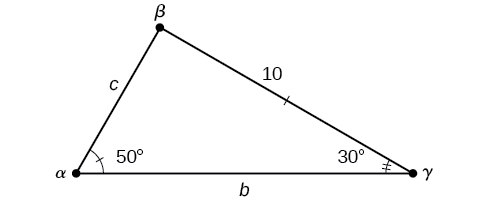
Figure \(\PageIndex{seven}\)
Solution
The three angles must add together up to 180 degrees. From this, we can determine that
\[\begin{marshal*} \beta &= 180^{\circ} - fifty^{\circ} - 30^{\circ}\\ &= 100^{\circ} \stop{align*}\]
To discover an unknown side, we demand to know the respective angle and a known ratio. Nosotros know that angle \(\alpha=50°\)and its respective side \(a=ten\). We can utilize the post-obit proportion from the Police of Sines to notice the length of \(c\).
\[\begin{align*} \dfrac{\sin(50^{\circ})}{10}&= \dfrac{\sin(30^{\circ})}{c}\\ c\dfrac{\sin(50^{\circ})}{10}&= \sin(xxx^{\circ})\qquad \text{Multiply both sides by } c\\ c&= \sin(30^{\circ})\dfrac{10}{\sin(50^{\circ})}\qquad \text{Multiply by the reciprocal to isolate } c\\ c&\approx 6.five \end{align*}\]
Similarly, to solve for \(b\), we set another proportion.
\[\begin{align*} \dfrac{\sin(50^{\circ})}{x}&= \dfrac{\sin(100^{\circ})}{b}\\ b \sin(fifty^{\circ})&= x \sin(100^{\circ})\qquad \text{Multiply both sides by } b\\ b&= \dfrac{ten \sin(100^{\circ})}{\sin(50^{\circ})}\qquad \text{Multiply by the reciprocal to isolate }b\\ b&\approx 12.ix \terminate{align*}\]
Therefore, the complete set of angles and sides is
\(\begin{matrix} \alpha=50^{\circ} & a=10\\ \beta=100^{\circ} & b\approx 12.ix\\ \gamma=30^{\circ} & c\approx half dozen.5 \stop{matrix}\)
Solve the triangle shown in Figure \(\PageIndex{eight}\) to the nearest tenth.

Figure \(\PageIndex{viii}\)
- Respond
-
\(\begin{matrix} \alpha=98^{\circ} & a=34.vi\\ \beta=39^{\circ} & b=22\\ \gamma=43^{\circ} & c=23.8 \stop{matrix}\)
Using The Law of Sines to Solve SSA Triangles
We tin can utilize the Law of Sines to solve any oblique triangle, but some solutions may not be straightforward. In some cases, more than ane triangle may satisfy the given criteria, which we describe equally an cryptic case. Triangles classified as SSA, those in which we know the lengths of two sides and the measurement of the bending opposite one of the given sides, may result in one or two solutions, or even no solution.
Oblique triangles in the category SSA may have four unlike outcomes. Effigy \(\PageIndex{9}\) illustrates the solutions with the known sides \(a\) and \(b\) and known angle \(\alpha\).
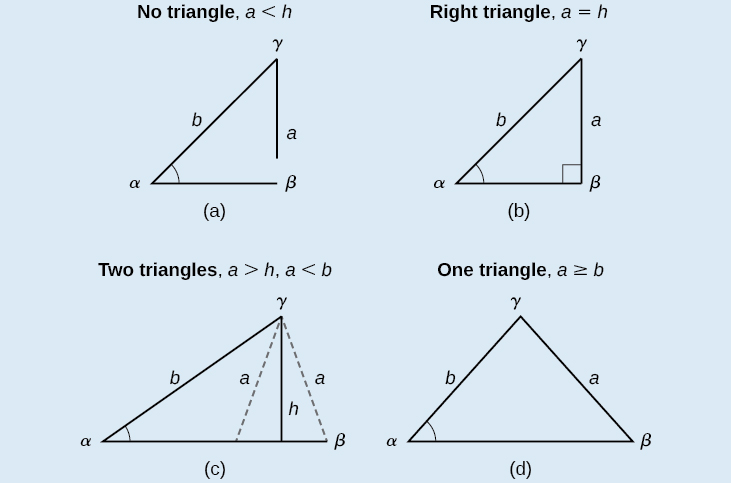
Figure \(\PageIndex{9}\)
Solve the triangle in Figure \(\PageIndex{10}\) for the missing side and notice the missing angle measures to the nearest tenth.
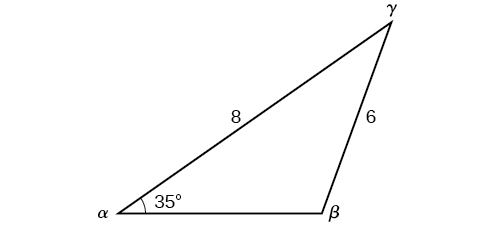
Figure \(\PageIndex{ten}\)
Solution
Utilize the Law of Sines to detect bending \(\beta\) and bending \(\gamma\), so side \(c\). Solving for \(\beta\), we take the proportion
\[\begin{align*} \dfrac{\sin \blastoff}{a}&= \dfrac{\sin \beta}{b}\\ \dfrac{\sin(35^{\circ})}{6}&= \dfrac{\sin \beta}{8}\\ \dfrac{eight \sin(35^{\circ})}{half dozen}&= \sin \beta\\ 0.7648&\approx \sin \beta\\ {\sin}^{-1}(0.7648)&\approx 49.9^{\circ}\\ \beta&\approx 49.ix^{\circ} \cease{align*}\]
Notwithstanding, in the diagram, bending \(\beta\) appears to be an birdbrained bending and may be greater than \(90°\). How did nosotros become an acute angle, and how do we find the measurement of \(\beta\)? Let's investigate further. Dropping a perpendicular from \(\gamma\) and viewing the triangle from a right angle perspective, nosotros have Figure \(\PageIndex{xi}\). It appears that there may be a 2nd triangle that will fit the given criteria.
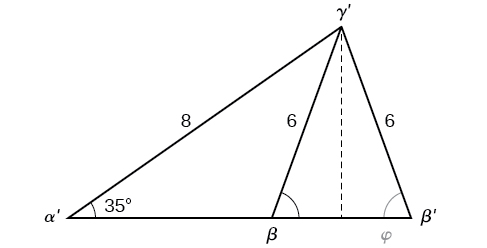
Figure \(\PageIndex{11}\)
The angle supplementary to \(\beta\) is approximately equal to \(49.ix°\), which means that \(\beta=180°−49.ix°=130.one°\). (Remember that the sine part is positive in both the starting time and 2nd quadrants.) Solving for \(\gamma\), we have
\[\begin{align*} \gamma&= 180^{\circ}-35^{\circ}-130.1^{\circ}\\ &\approx xiv.ix^{\circ} \stop{align*}\]
We tin then use these measurements to solve the other triangle. Since \(\beta′\) is supplementary to \(\beta\), we have
\[\begin{align*} \gamma^{'}&= 180^{\circ}-35^{\circ}-49.5^{\circ}\\ &\approx 95.1^{\circ} \end{marshal*}\]
Now nosotros need to find \(c\) and \(c′\).
We have
\[\begin{align*} \dfrac{c}{\sin(14.ix^{\circ})}&= \dfrac{half dozen}{\sin(35^{\circ})}\\ c&= \dfrac{6 \sin(14.9^{\circ})}{\sin(35^{\circ})}\\ &\approx two.7 \stop{align*}\]
Finally,
\[\begin{align*} \dfrac{c'}{\sin(95.1^{\circ})}&= \dfrac{half-dozen}{\sin(35^{\circ})}\\ c'&= \dfrac{6 \sin(95.1^{\circ})}{\sin(35^{\circ})}\\ &\approx x.4 \stop{align*}\]
To summarize, in that location are ii triangles with an bending of \(35°\), an adjacent side of 8, and an opposite side of half-dozen, as shown in Figure \(\PageIndex{12}\).
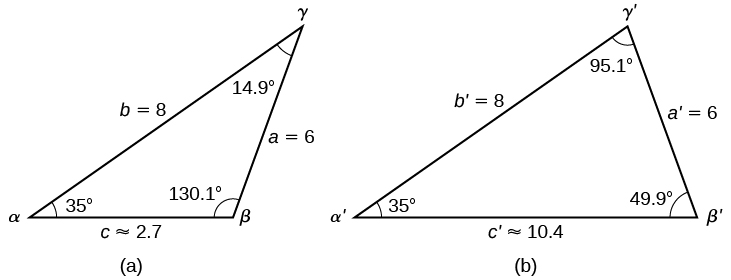
Figure \(\PageIndex{12}\)
However, we were looking for the values for the triangle with an birdbrained bending \(\beta\). Nosotros tin meet them in the first triangle (a) in Figure \(\PageIndex{12}\).
Given \(\alpha=80°\), \(a=120\), and \(b=121\), find the missing side and angles. If there is more than one possible solution, evidence both.
- Reply
-
Solution ane
\(\begin{matrix} \alpha=80^{\circ} & a=120\\ \beta\approx 83.2^{\circ} & b=121\\ \gamma\approx 16.eight^{\circ} & c\approx 35.2 \finish{matrix}\)
Solution 2
\(\begin{matrix} \blastoff '=fourscore^{\circ} & a'=120\\ \beta '\approx 96.8^{\circ} & b'=121\\ \gamma '\approx three.two^{\circ} & c'\approx 6.eight \cease{matrix}\)
In the triangle shown in Figure \(\PageIndex{thirteen}\), solve for the unknown side and angles. Round your answers to the nearest tenth.
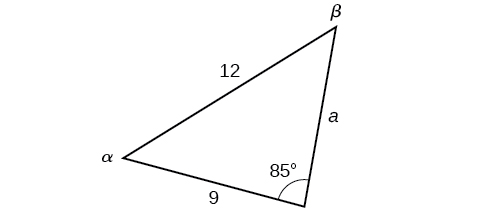
Figure \(\PageIndex{13}\)
Solution
In choosing the pair of ratios from the Police of Sines to use, look at the information given. In this case, we know the angle, \(\gamma=85°\), and its respective side \(c=12\), and nosotros know side \(b=9\). Nosotros will use this proportion to solve for \(\beta\).
\[\brainstorm{align*} \dfrac{\sin(85^{\circ})}{12}&= \dfrac{\sin \beta}{9}\qquad \text{Isolate the unknown.}\\ \dfrac{9 \sin(85^{\circ})}{12}&= \sin \beta \end{marshal*}\]
To find \(\beta\), utilize the inverse sine role. The inverse sine volition produce a unmarried result, simply keep in mind that there may be two values for \(\beta\). It is important to verify the upshot, as in that location may be two viable solutions, only one solution (the usual example), or no solutions.
\[\begin{align*} \beta&= {\sin}^{-1}\left(\dfrac{9 \sin(85^{\circ})}{12}\right)\\ \beta&\approx {\sin}^{-1} (0.7471)\\ \beta&\approx 48.3^{\circ} \end{align*}\]
In this instance, if we subtract \(\beta\) from \(180°\), we find that there may be a 2d possible solution. Thus, \(\beta=180°−48.3°≈131.seven°\). To check the solution, subtract both angles, \(131.7°\) and \(85°\), from \(180°\). This gives
\[\begin{marshal*} \alpha&= 180^{\circ}-85^{\circ}-131.7^{\circ}\\ &\approx -36.7^{\circ} \end{marshal*}\]
which is incommunicable, and so \(\beta≈48.3°\).
To find the remaining missing values, we calculate \(\alpha=180°−85°−48.three°≈46.seven°\). At present, only side \(a\) is needed. Employ the Law of Sines to solve for \(a\) by one of the proportions.
\[\begin{align*} \dfrac{\sin(85°)}{12}&= \dfrac{\sin(46.7^{\circ})}{a}\\ a\dfrac{\sin(85^{\circ})}{12}&= \sin(46.7^{\circ})\\ a&=\dfrac{12\sin(46.7^{\circ})}{\sin(85^{\circ})}\\ &\approx eight.8 \end{align*}\]
The consummate set of solutions for the given triangle is
\(\begin{matrix} \alpha\approx 46.vii^{\circ} & a\approx eight.8\\ \beta\approx 48.3^{\circ} & b=9\\ \gamma=85^{\circ} & c=12 \end{matrix}\)
Given \(\alpha=80°\), \(a=100\), \(b=x\), find the missing side and angles. If in that location is more than one possible solution, show both. Round your answers to the nearest tenth.
- Answer
-
\(\beta≈v.7°\), \(\gamma≈94.3°\), \(c≈101.3\)
Find all possible triangles if one side has length \(4\) opposite an angle of \(l°\), and a second side has length \(10\).
Solution
Using the given data, we can solve for the angle opposite the side of length \(10\). Come across Effigy \(\PageIndex{14}\).
\[\begin{align*} \dfrac{\sin \blastoff}{10}&= \dfrac{\sin(fifty^{\circ})}{4}\\ \sin \alpha&= \dfrac{10 \sin(50^{\circ})}{four}\\ \sin \alpha&\approx 1.915 \end{align*}\]
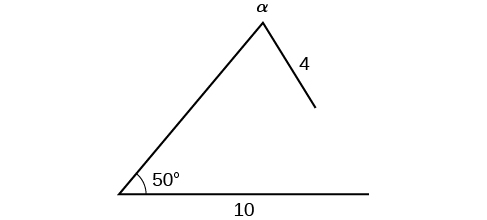
Figure \(\PageIndex{xiv}\)
We tin can stop here without finding the value of \(\alpha\). Because the range of the sine function is \([ −1,ane ]\), information technology is impossible for the sine value to be \(1.915\). In fact, inputting \({\sin}^{−ane}(1.915)\) in a graphing calculator generates an Mistake DOMAIN. Therefore, no triangles can be fatigued with the provided dimensions.
Make up one's mind the number of triangles possible given \(a=31\), \(b=26\), \(\beta=48°\).
- Reply
-
two
Finding the Area of an Oblique Triangle Using the Sine Office
Now that we can solve a triangle for missing values, we can utilise some of those values and the sine function to find the area of an oblique triangle. Recall that the surface area formula for a triangle is given as \(Area=\dfrac{one}{2}bh\), where \(b\) is base and \(h\) is height. For oblique triangles, we must discover \(h\) before we tin can use the area formula. Observing the 2 triangles in Figure \(\PageIndex{15}\), one acute and one obtuse, we can drop a perpendicular to represent the summit and so apply the trigonometric belongings \(\sin \blastoff=\dfrac{contrary}{hypotenuse}\) to write an equation for area in oblique triangles. In the astute triangle, we have \(\sin \alpha=\dfrac{h}{c}\) or \(c \sin \blastoff=h\). However, in the birdbrained triangle, we drop the perpendicular outside the triangle and extend the base of operations \(b\) to form a correct triangle. The bending used in calculation is \(\alpha′\), or \(180−\alpha\).

Figure \(\PageIndex{xv}\)
Thus,
\(Surface area=\dfrac{1}{2}(base)(height)=\dfrac{i}{two}b(c \sin \alpha)\)
Similarly,
\(Area=\dfrac{1}{2}a(b \sin \gamma)=\dfrac{1}{2}a(c \sin \beta)\)
The formula for the surface area of an oblique triangle is given by
\[Expanse=\dfrac{i}{two}bc \sin \alpha\]
\[Area=\dfrac{1}{2}air-conditioning \sin \beta\]
\[Expanse=\dfrac{one}{ii}ab \sin \gamma\]
This is equivalent to half of the product of 2 sides and the sine of their included bending.
Observe the area of a triangle with sides \(a=90\), \(b=52\), and angle \(\gamma=102°\). Round the area to the nearest integer.
Solution
Using the formula, we accept
\[\begin{marshal*} Area&= \dfrac{1}{2}ab \sin \gamma\\ Area&= \dfrac{one}{two}(ninety)(52) \sin(102^{\circ})\\ Expanse&\approx 2289\; \text{square units} \cease{align*}\]
Find the area of the triangle given \(\beta=42°\), \(a=7.two ft\), \(c=iii.4 ft\). Circular the area to the nearest tenth.
- Answer
-
nigh \(8.2\) square feet
Solving Applied Bug Using the Law of Sines
The more we study trigonometric applications, the more we find that the applications are countless. Some are flat, diagram-type situations, but many applications in calculus, engineering, and physics involve three dimensions and move.
Notice the altitude of the aircraft in the trouble introduced at the beginning of this department, shown in Figure \(\PageIndex{16}\). Round the altitude to the nearest 10th of a mile.

Figure \(\PageIndex{sixteen}\)
Solution
To find the elevation of the aircraft, we beginning notice the distance from one station to the aircraft, such as the side \(a\), and then use right triangle relationships to notice the acme of the aircraft, \(h\).
Because the angles in the triangle add upward to \(180\) degrees, the unknown bending must exist \(180°−15°−35°=130°\). This bending is contrary the side of length \(xx\), allowing u.s. to set up a Constabulary of Sines human relationship.
\[\begin{align*} \dfrac{\sin(130^{\circ})}{20}&= \dfrac{\sin(35^{\circ})}{a}\\ a \sin(130^{\circ})&= twenty \sin(35^{\circ})\\ a&= \dfrac{20 \sin(35^{\circ})}{\sin(130^{\circ})}\\ a&\approx fourteen.98 \cease{align*}\]
The distance from i station to the shipping is about \(xiv.98\) miles.
Now that nosotros know \(a\), we tin can utilise right triangle relationships to solve for \(h\).
\[\brainstorm{align*} \sin(15^{\circ})&= \dfrac{opposite}{hypotenuse}\\ \sin(15^{\circ})&= \dfrac{h}{a}\\ \sin(xv^{\circ})&= \dfrac{h}{14.98}\\ h&= 14.98 \sin(15^{\circ})\\ h&\approx 3.88 \end{align*}\]
The aircraft is at an altitude of approximately \(3.9\) miles.
The diagram shown in Figure \(\PageIndex{17}\) represents the pinnacle of a stuffed flying over a football stadium. Find the height of the stuffed if the angle of elevation at the southern end zone, point A, is \(70°\), the bending of elevation from the northern finish zone, bespeak B, is \(62°\), and the distance between the viewing points of the 2 terminate zones is \(145\) yards.
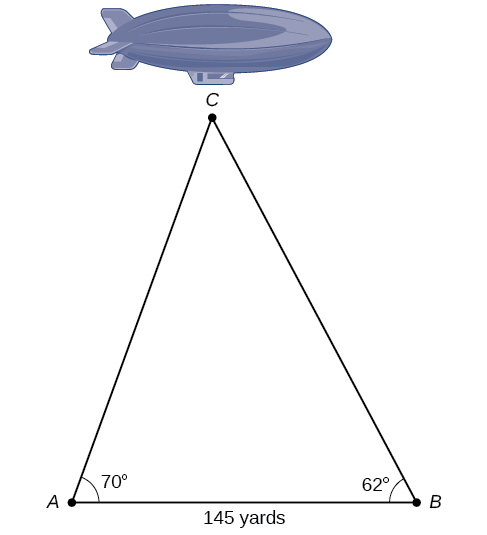
Figure \(\PageIndex{17}\)
- Respond
-
\(161.9\) yd.
Fundamental Equations
| Law of Sines | \(\dfrac{\sin \alpha}{a}=\dfrac{\sin \beta}{b}=\dfrac{\sin \gamma}{c}\) \(\dfrac{a}{\sin \alpha}=\dfrac{b}{\sin \beta}=\dfrac{c}{\sin \gamma}\) |
| Area for oblique triangles | \(Surface area=\dfrac{ane}{two}bc \sin \alpha\) \(=\dfrac{i}{2} air conditioning \sin \beta\) \(=\dfrac{1}{2} ab \sin \gamma\) |
Key Concepts
- The Law of Sines can be used to solve oblique triangles, which are non-right triangles.
- According to the Police of Sines, the ratio of the measurement of one of the angles to the length of its opposite side equals the other two ratios of bending mensurate to opposite side.
- There are 3 possible cases: ASA, AAS, SSA. Depending on the information given, we tin can cull the appropriate equation to find the requested solution. Encounter Example \(\PageIndex{ane}\).
- The ambiguous instance arises when an oblique triangle can have unlike outcomes.
- There are iii possible cases that arise from SSA organization—a single solution, two possible solutions, and no solution. Encounter Instance \(\PageIndex{ii}\) and Example \(\PageIndex{3}\).
- The Law of Sines tin be used to solve triangles with given criteria. See Example \(\PageIndex{4}\).
- The general area formula for triangles translates to oblique triangles by first finding the appropriate height value. Run across Example \(\PageIndex{5}\).
- In that location are many trigonometric applications. They can oftentimes be solved by first drawing a diagram of the given information and so using the appropriate equation. Come across Example \(\PageIndex{half-dozen}\).
Source: https://math.libretexts.org/Courses/Prince_Georges_Community_College/MAT_1350%3A_Precalculus_Part_I/10%3A_Further_Applications_of_Trigonometry/10.01%3A_Non-right_Triangles_-_Law_of_Sines
Posted by: perezcardearty62.blogspot.com



0 Response to "How To Find Angle Measures With Side Lengths"
Post a Comment